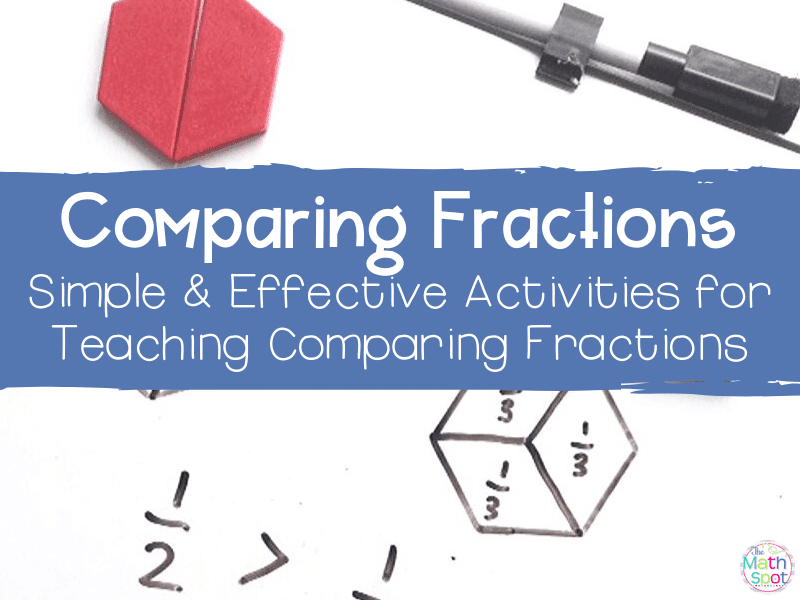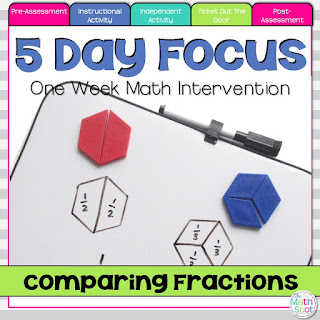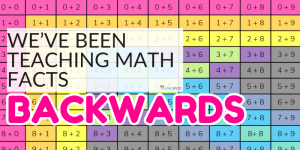This post contains affiliate links. This means that when you make a purchase, at no additional cost to you, I will earn a small commission.

We are heading into post #3 of my four-part fraction comparison series. If you haven’t read post #1 and post #2 take a quick break to go and read those now!
Now that we are all caught up, let’s do a quick recap of the big ideas:
- Students have had A LOT of experience in the whole number world. They WILL make generalizations that don’t necessarily work for fractions if you don’t ground them in concrete experiences.
- Concrete experiences come in all sorts of shapes and sizes! There is no one perfect concrete model and the more concrete experiences you expose your students to the more anchors they have from which to draw future connections.
In post #2 I mentioned using fraction bars in a variety of forms including Cuisenaire Rods and Fraction bars or tiles. A logical representative step from these type of models would be to move towards a tape diagram. The prompt can be as simple as “Can you draw a tape diagram to match your fraction bars?” From there you will want to ask the students many questions to be sure they are drawing explicit connections between the concrete and the representative models.
Consider giving students a task such as Use fraction bars to show whether 1/4 or 1/2 is greater. After the students had built models for 1/4 and 1/2 you would then say to them Draw a tape diagram that matches your fraction bars to show whether 1/4 or 1/2 is greater. Ask students to discuss with one another how their pictures match the bars or tiles that they built with. Ask students to point to the part in their drawing that matches the 1/2 bar. Ask students to point to the part in their drawing that matches the 1/4 tiles. Point out the discrepancies that you notice that a student doesn’t! Are they not noticing that the whole needs to be the same size in their 1/2 and 1/4 tape diagrams? Ask students to describe, describe, describe how they came up with their representation. Before you know it, they will be able to use tape diagrams to show these comparisons without needing the materials first.
All drawings don’t need to be formal. I described using a tape diagram above but an informal drawing that represents what happened in a story problem will go very far in terms of allowing students to develop a spatial understanding of the fractions they are working with.
Consider if you had told students an “epic” story problem about a round pizza. It would be a much larger leap for your students to make a matching drawing if you asked them to do so with a tape diagram. I am NOT saying that you shouldn’t ask them to use a tape diagram to represent a “round” problem. But I am advocating that if you know moving to a drawing or representation will be a challenge for your students that you begin by asking them to make a representation that more closely aligns with the original problem. You can spend time in more than one concrete model or more than one representation. It would be beyond fair for you to ask students to draw circles showing what happened to a pizza and then asking them to draw a tape diagram that matches their circles.
This is a progression, it is about being thoughtful, it is about knowing your students, it is about being as developmentally mindful as you can while building these big concepts!
You may have heard that in the primary (K-2) world there is a BIG difference for students if they are counting to 10 on a number line vs. a number path. A number line marks the “end” of each period whereas a number path consists of adjoining boxes each representing a piece to the path. For primary students it is much easier to understand a number path than a number line because they can see that two, for instance, is two boxes on a number path. On a number line 2 looks like a finite point and they don’t necessarily understand that everything up to that two constitutes the whole 2 we are talking about.
In the intermediate world you can liken this to the difference between a tape diagram and a number line. A tape diagram is essentially a number path- you can see the full box that constitutes each period. A number line is much more difficult to interpret.
A ruler, however, is a tool that many students are very familiar with and, if you use rulers with only specific fractions marked off (see post #2 for concrete examples) your students will be set up for success in number line work. Students can begin moving toward a number line by drawing and representing what they found on a ruler on a number line. To further ease the transition of using a number line to represent fractions, you may ask your students to shade in or highlight the number line up to a given number. This will create a visual that is almost a hybrid between a tape diagram and a number line.
I described in the previous post how students could use pattern blocks to explore unit fractions and beyond when they are first comparing fractions. A simple transition between concrete and abstract is presented when your students are learning with pattern blocks. Students can simply trace the pattern blocks and label the unit fractions on their drawings. In this way, students can represent unit fractions while still having the opportunity to manipulate the materials first.
As mentioned many times, throughout this post and the previous two, the real power in the C-R-A framework is asking the questions that join together the concrete models to the representations that students are drawing or interpreting. Ultimately, these connections will help students to begin to think in a more abstract way about these numbers and concepts.
In my next post I will help you to tie it all together and to ask questions that are dangerously effective towards helping your students to achieve mastery in fraction comparison!
Post 1: The Math Spot Compares Fractions- Introduction
Post 2: The Math Spot Compares Fractions- Comparison Tools
Post 3: The Math Spot Compares Fractions- Representative Models
Post 4: The Math Spot Compares Fractions- Abstract Thinking
Related Resources:










